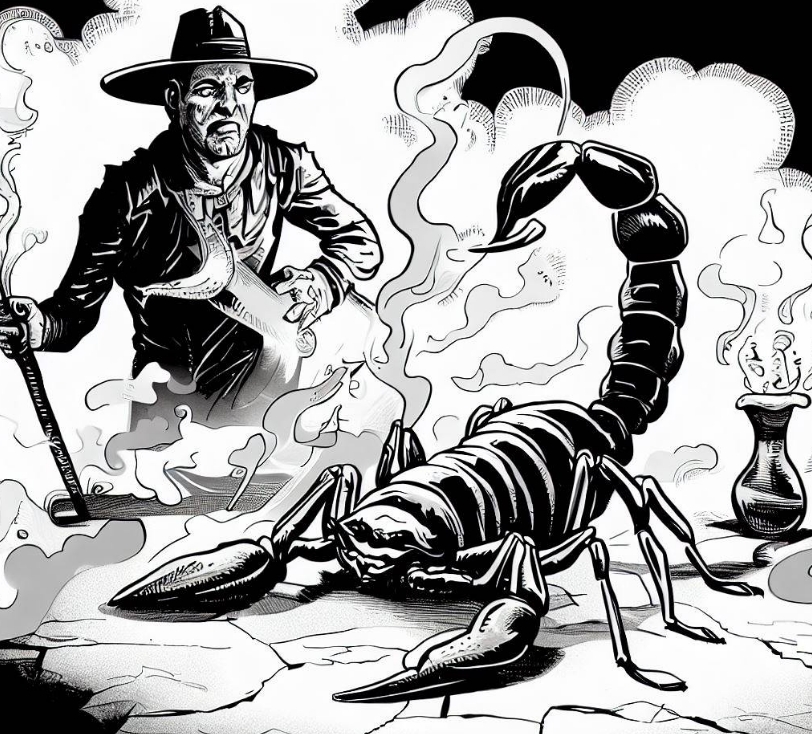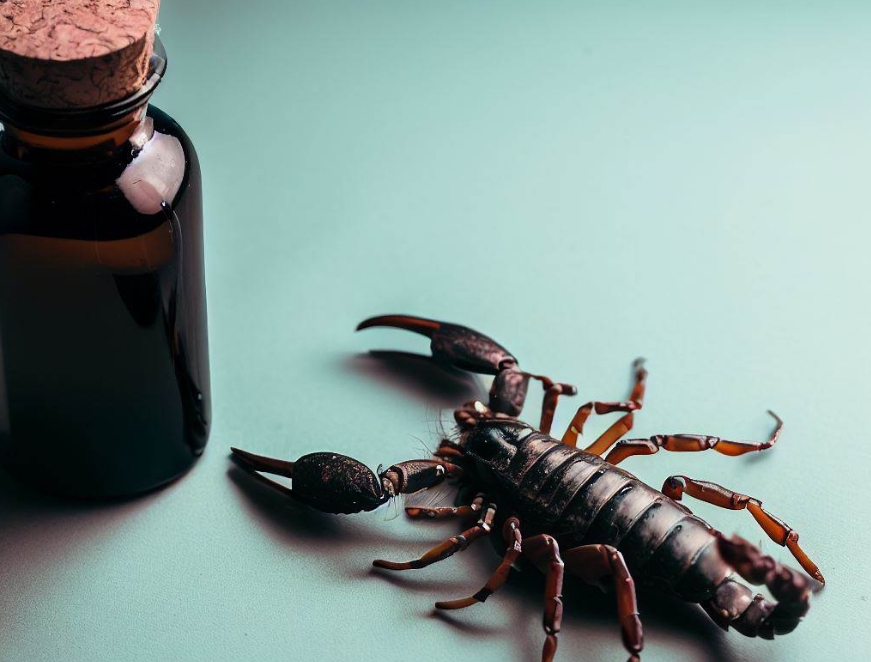Scorpions have long fascinated people with their unique and mysterious appearance. In particular, ultra violet and black scorpions have captured our attention due to their captivating colors and distinctive features. This comprehensive guide will take you on a journey to explore these enigmatic creatures, their unique attributes, and how to safely observe them in their natural habitat.
The Intriguing Scorpion: An Arachnid, Not an Insect
Contents
Before delving into the fascinating world of ultra violet and black scorpions, it’s essential to clarify a common misconception: scorpions are not insects but rather members of the arachnid family. Best Pest World provides an excellent explanation of the key differences between insects and arachnids. In short, scorpions are arachnids, closely related to spiders, ticks, and mites.
Unveiling the Ultra Violet Scorpion: A Natural Phenomenon
One of the most striking aspects of scorpions is their ability to glow under ultraviolet (UV) light. This natural phenomenon is not limited to a specific species or color but is a characteristic shared by all scorpions. When exposed to UV light, a scorpion’s exoskeleton emits a vivid, greenish-blue glow that can be quite mesmerizing.
The Science Behind the Glow
The glowing effect is due to the presence of fluorescent compounds in a scorpion’s exoskeleton. These compounds absorb UV light and re-emit it as visible light, creating the distinctive glow. While the exact function of this fluorescence remains a mystery, some theories suggest it may help scorpions find each other in the dark, deter predators, or even protect them from harmful UV radiation.
Enter the Black Scorpion: A Fearsome Predator
The term “black scorpion” generally refers to any scorpion species with a predominantly dark or black coloration. Some well-known examples include the Emperor Scorpion (Pandinus imperator) and the Asian Forest Scorpion (Heterometrus sp.). These black scorpions are known for their impressive size, aggressive behavior, and powerful venom, making them formidable predators in their respective ecosystems.
Emperor Scorpion: The Gentle Giant
Despite its fearsome appearance, the Emperor Scorpion is considered one of the more docile species and is even popular as an exotic pet. They are native to the rainforests of West Africa and can grow up to 8 inches in length. Although their venom is potent, it’s rarely lethal to humans, and their sting is often compared to that of a bee.
Asian Forest Scorpion: A Cautious Hunter
The Asian Forest Scorpion, found in the tropical forests of Southeast Asia, is another large black scorpion species. They are known for their cautious and defensive behavior. While their venom is not as potent as some other species, they can still deliver a painful sting. It’s essential to exercise caution when encountering these creatures in the wild.
Observing Ultra Violet and Black Scorpions: A Step-By-Step Guide
To safely observe ultra violet and black scorpions in their natural habitat, follow these simple steps:
- Choose the right location: Scorpions can be found in various habitats, including deserts, grasslands, forests, and caves. Research the specific species you’re interested in and select a location where they are known to reside.
- Prepare for a nighttime adventure: Scorpions are primarily nocturnal, so your best chance of observing them is after the sun has set. Plan your excursion accordingly and make sure to dress appropriately for the environment and weather conditions.
- Bring the right equipment: To observe scorpions under UV light, you’ll need a portable UV flashlight. These can be found at outdoor supply stores or online. Also, consider bringing a camera with night vision capabilities to capture the glowing scorpions in action.
- Stay safe: While exploring scorpion habitats, be cautious and wear protective clothing, such as long pants, closed-toe shoes, and gloves. Avoid touching or handling scorpions, as their sting can be painful and, in some cases, dangerous.
- Scan the terrain: Once you’re in the right location, turn on your UV flashlight and start scanning the ground, rocks, and vegetation. The glowing scorpions should be easy to spot under the UV light.
- Observe from a distance: When you spot a scorpion, observe it from a safe distance. Do not attempt to handle or disturb the creature, as this may provoke a defensive response.
- Document your findings: Record your observations, take photographs, and even jot down notes about the scorpion’s behavior, size, and appearance. This information can be valuable for research purposes and can help you learn more about these fascinating creatures.
Brands for Scorpion Enthusiasts: UV Flashlights and Night Vision Cameras
If you’re serious about observing ultra violet and black scorpions, investing in high-quality equipment is essential. Here are some top brands to consider for your UV flashlight and night vision camera needs:
UV Flashlights
- Streamlight: Known for their durable and reliable flashlights, Streamlight offers a range of UV options suitable for scorpion hunting.
- UV Beast: This brand specializes in UV flashlights, providing powerful and long-lasting illumination to help you spot scorpions with ease.
Night Vision Cameras
- Bushnell: A trusted name in outdoor optics, Bushnell offers a selection of night vision cameras perfect for capturing scorpions in action.
- Nightfox: With a focus on affordability and performance, Nightfox provides night vision cameras that deliver excellent results without breaking the bank.
Ultra Violet and Black Scorpions: A World of Mystery and Wonder
The captivating world of ultra violet and black scorpions offers a glimpse into the mysterious lives of these enigmatic creatures. With a little preparation, the right equipment, and a sense of adventure, you can embark on a thrilling journey to discover these fascinating arachnids in their natural habitat. Whether you’re an amateur naturalist or a seasoned wildlife enthusiast, the allure of scorpions is sure to captivate your imagination and deepen your appreciation for the incredible diversity of life on our planet.
Conservation and Ethical Considerations
As you embark on your journey to explore the world of ultra violet and black scorpions, it’s important to remember our responsibility towards these unique creatures and their ecosystems. Here are a few conservation and ethical guidelines to keep in mind:
- Respect the habitat: When venturing into scorpion territory, take care not to damage or disturb their environment. Stick to established trails and avoid trampling on vegetation or disrupting rock formations.
- Do not collect specimens: While it might be tempting to take a scorpion home as a souvenir, removing them from their natural habitat can have negative consequences for their populations and ecosystems. Instead, focus on observing and photographing the scorpions and leave them where you found them.
- Report your findings: If you come across a rare or endangered scorpion species, consider reporting your sighting to local conservation organizations or wildlife authorities. Your observations could contribute valuable data for research and conservation efforts.
- Promote scorpion conservation: Share your passion for scorpions with others and help raise awareness about the importance of protecting these fascinating creatures and their habitats. By educating others, you can help foster a greater appreciation for scorpions and encourage responsible wildlife tourism.
Scorpion-inspired Products and Artwork
As you delve deeper into the world of ultra violet and black scorpions, you might find yourself inspired to celebrate these incredible creatures in your everyday life. From home décor to fashion, there’s a myriad of ways to incorporate scorpion motifs and imagery into your personal style. Here are a few ideas to get you started:
- Home décor: Bring the intrigue of scorpions into your living space with themed artwork, sculptures, or even decorative pillows featuring scorpion designs.
- Clothing and accessories: Showcase your love for scorpions with statement pieces such as t-shirts, hats, or jewelry adorned with scorpion symbols or patterns.
- Art and photography: Capture the beauty of scorpions in your own artwork, whether through painting, drawing, or photography. You could even create a gallery wall featuring your favorite scorpion-inspired pieces.
Final Thoughts on Ultra Violet and Black Scorpions
The world of ultra violet and black scorpions is a fascinating realm filled with mystery, wonder, and intrigue. By exploring their habitats, observing their behavior, and learning about their unique characteristics, you can deepen your understanding of these captivating creatures and gain a new appreciation for the incredible diversity of life on Earth.
FAQ About Ultra Violet and Black Scorpions
To help you better understand the intriguing world of ultra violet and black scorpions, we’ve compiled a list of frequently asked questions and their answers.
Q1: Are all scorpions dangerous to humans?
A: While all scorpions possess venom, not all are dangerous to humans. The potency of their venom varies greatly among species, with only about 25 species known to have venom potent enough to cause serious harm or death in humans. It’s important to exercise caution around scorpions and avoid handling them.
Q2: Why do scorpions glow under UV light?
A: Scorpions glow under UV light due to the presence of fluorescent compounds in their exoskeleton. These compounds absorb UV light and re-emit it as visible light, creating the characteristic glow. The exact function of this fluorescence is still a mystery, with theories suggesting it may help scorpions find each other in the dark, deter predators, or protect them from harmful UV radiation.
Q3: Can I keep a black scorpion as a pet?
A: Some species of black scorpions, such as the Emperor Scorpion, can be kept as exotic pets. However, it’s crucial to research the specific species, their care requirements, and legal restrictions before acquiring a scorpion as a pet. Keep in mind that scorpions have specific environmental and dietary needs and can potentially deliver a painful sting.
Q4: Where can I find ultra violet and black scorpions in the wild?
A: Scorpions inhabit various ecosystems worldwide, including deserts, grasslands, forests, and caves. To find ultra violet and black scorpions, you’ll need to research the specific species you’re interested in and choose a location where they are known to reside. Keep in mind that scorpions are primarily nocturnal, so your best chance of observing them is after the sun has set.
Q5: Can I use a regular flashlight to observe scorpions?
A: While a regular flashlight might help you spot scorpions in the dark, it won’t reveal the fluorescent glow that’s visible under UV light. To observe the glow, you’ll need a portable UV flashlight, which can be found at outdoor supply stores or online.
Q6: Are ultra violet and black scorpions endangered?
A: The conservation status of scorpions varies among species. Some species are abundant and not considered endangered, while others may face threats due to habitat loss, pesticide exposure, or collection for the pet trade. It’s essential to respect scorpion habitats and follow ethical guidelines when observing these creatures in the wild.





